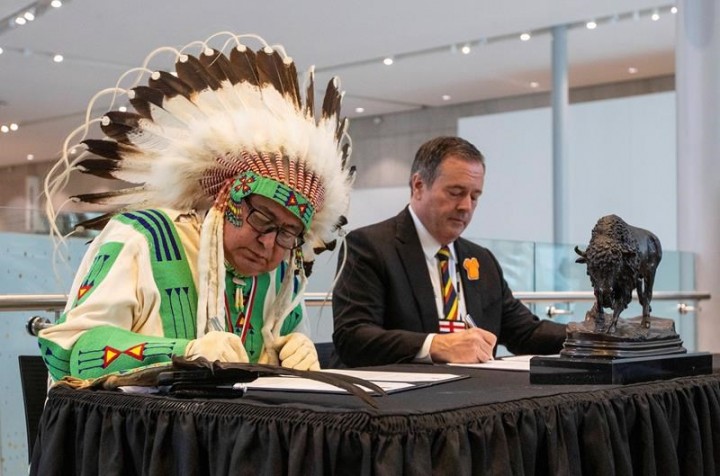After years of negotiations, the Alberta government signed an agreement Friday with a First Nations group committing to return an ancient meteorite to its historic location after being displaced for over 150 years.
Manitou Asinîy, also known as the Creator's Stone or Manitou Stone, is a 145-kilogram iron meteorite that landed close to the Alberta-Saskatchewan boundary, near modern-day Hardisty, Alta., billions of years ago.
The chestnut-coloured stone weighs about the same as a red-tailed deer and is the size of a large tire.
The stone holds spiritual significance to Indigenous people across the Prairies and was thought to have healing properties and protect buffalo herds.
The stone was taken in the late 1860s by Rev. George McDougall, who attempted to use it as a way to draw Indigenous people to Christianity. It was then sent to the Victoria Methodist College in Ontario.
When the stone was taken by McDougall, Indigenous spiritual leaders prophesized illness and famine that soon came to fruition with the introduction of smallpox and the mass killing of buffalo herds by colonizers.
The Royal Ontario Museum displayed the stone until 1972 when it was placed on long-term loan with the Royal Alberta Museum in Edmonton.

Consultations between the museum and Indigenous groups about the fate of the stone started in 2002.
Elder Leonard Bastien said the return of the stone is important to reawakening a sense of peace, prosperity, hope and healing for all people.
"It is my hope, my faith and belief that tomorrow will be better for us," he said.
Bastien is chair of the Manitou Asinîy-Iniskim-Tsa Xani Center, the group that engaged with several Indigenous communities and elders to build consensus around the future of the stone.
At the ceremony, Premier Jason Kenney spoke of his first time learning about the stone in a history book several years ago.
"It does not and should not belong to the government of Alberta," said Kenney. "It does, and must belong, to the First Nations of these lands."
Kenney said returning the stone marks a deeply meaningful moment of reconciliation.
Bastien praised Kenney for his actions to repatriate the stone. "You moved mountains for us."
A geodesic dome designed by Indigenous architect Douglas Cardinal will be the stone's new home and serve as a prayer centre. The structure will be built over the next couple of years and will cost between $7.5 million and $10 million.
Blaine Favel, former chief of Poundmaker Cree Nation in Saskatchewan, said they are in the process of final land negotiations and that funding has started to come in from corporate donors.
Favel said that the prayer centre will help preserve culture and traditions for future generations.
The Royal Alberta Museum will continue to house and take care of the stone until the centre is built.
Hardisty, Alta., is about 200 kilometres southeast of Edmonton.
















